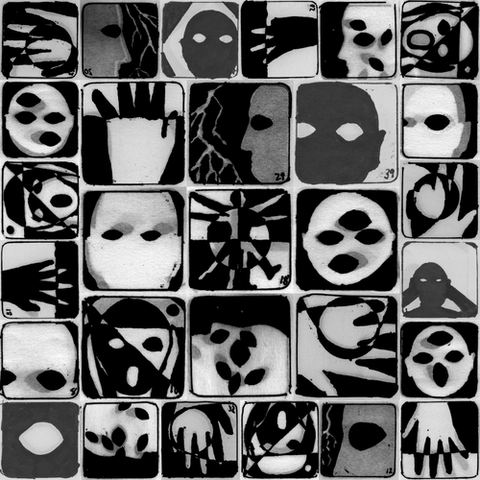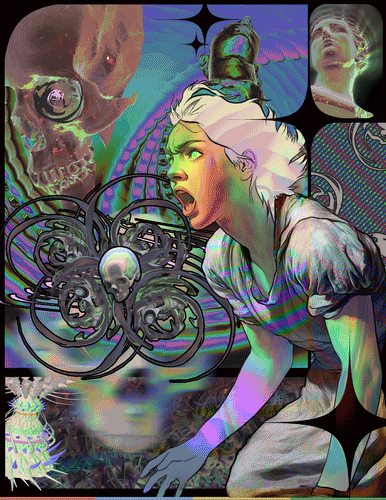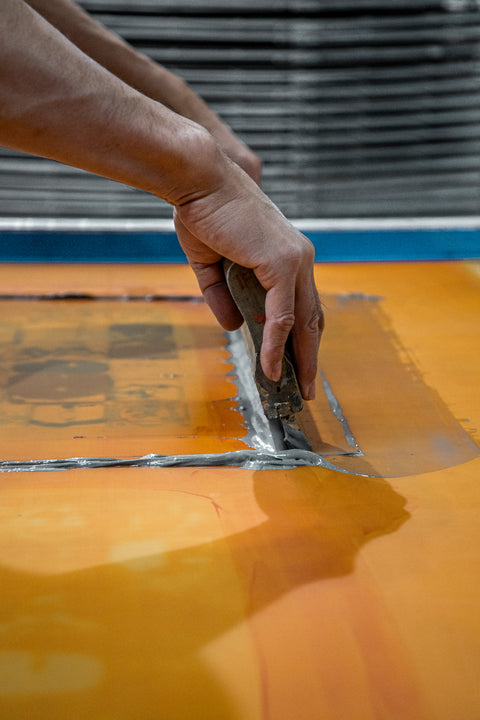
Jake Fried (b 1984) is a boundary-pushing American artist known for his hand drawn animations and films. Trained as a painter, Jake's early works are large and rich with texture; abstract, while calling on familiar symbols and imagery. He'd find himself reworking the same paintings for months, applying layer after layer. Jake became fascinated by how the paintings evolved over time, and the story each layer could tell. This led him to start documenting the stages in 2011, and ultimately spawned the films we know today. Last year, Jake welcomed his second daughter into the world - with two kids under 5 came new time management, new routines, and a new outlet for artistic exploration.
Outer Reaches is sold out! Collectors receive the original film as an ERC721 token, as well as a 16x16 inch framed screenprint of the work. The release is a limited edition of 30.
C4RDINAL: Jake, super excited for this. What day is it today, and what's on the agenda?!
JAKE FRIED: Of course, it’s good to be with you. It’s Friday [Oct 25th], we just announced Outer Reaches, so my main agenda today is to promote and share about the project, answer questions from interested collectors, etc.
Also, I’m planning an upcoming exhibition in collaboration with AOTM Gallery and NINFA. My most recent 1/1, Brain Wave, is being featured in the Gojira/Korn North America Tour, and I recently had my work screened at a massive scale in Poland. So I’ll spend some time on YouTube and IG looking for good footage of those events from last night. It’s always nice to have documentation, and I think it’s important for my collectors and audience to see how my work is being presented in real time, in real spaces around the world.
I’m also working on a commission/licensing deal for a very mainstream music project that should be out soon, excited about that.
At noon I’ll be doing a Twitter spaces with HARDART, who I had the chance to meet recently in NYC at the Subjective Art Festival. I screened Outer Reaches for the first time, in an immersive video space, at the festival.
And then, hopefully, I’ll have some time to draw. I’m still working on these small flip-books, which have been very fruitful for me creatively since earlier this year. I’m thinking about what comes next after Outer Reaches, and how I can expand upon this visual language that I’ve been developing.
Late afternoon, my wife and I will pick up our 4yr old from school, and our 10mo old, who just started daycare part-time. Hang out with family, make dinner. We only let our older daughter watch movies on Friday night, so hopefully she picks something good. She’s been getting into Studio Ghibli films recently, which has been awesome.

Brain Wave at the Gojira show in Tampa, FL, Sept 12 2024.
C4: We're stoked to be collaborating with you on the release of Outer Reaches, both digitally and physically! 9 unique animations make up 1 short film. You've been working in different mediums and conditions this year, tell us about how Outer Reaches came together!
JAKE: Like I was saying, I’ve been working on these small flip-books recently, which is a departure from my typical approach, where I rework and scan a highly-detailed drawing over and over again. That process is extremely time consuming and labor intensive, which is why I like it, but it’s nearly impossible to work that way while watching a baby, and everything else that has been going on. With the small flip-books - I just use a sharpie and a standard pad of post-it notes taped together - I can work quickly and freely, I can work on the floor or outside, without being tied to my scanner and computer.
I carry these flip-books around in my pocket, and pull them out when I have a chance to work. This process forces me to be more spontaneous with my ideas. The small scale of the drawings force me to limit detail - to focus purely on essential movements and forms. It’s allowing the work to come from a more subconscious place and helps me emphasize the hand-made, human quality of my expression.
Art-making for me is a discovery process, I rarely know where I’m going when I start, I try to let the work lead me to where it wants to go. I started making these flip-books because I needed to create, I had to adapt from my usual working methods. Through this late spring and summer I did 9 flip-books in a row, that I was sharing one at a time on social media, that all felt connected. I began to realize that I was making a series or a larger piece of some kind.
From there I began putting the flip-books in sequence, like a short film, one after the other. I could see there was more power in juxtaposing the sequences against each other, rather than keeping each one separate. It raised the sense of a larger narrative, different parts of the same being, an interconnectedness. The ultimate breakthrough was creating the grid pattern we see in the final piece, with all the pieces playing simultaneously side by side. I played with dozens of variations until I landed on the perfect orientation, all 9 animations in the center, with smaller repetitions surrounding them.
When I was posting the original flip-books, one by one, I carefully composed scratch tracks using heavily distorted and layered soundscapes that I felt matched the energy of the work. For Outer Reaches, I took all 9 tracks and blended them together to create the final sound design. I think of it as a universal humming, an elevated white noise, disquieting and comforting.
Many people have commented that the work, visually and audibly, feels like their dreams, what it’s like inside their head, what a memory feels like, a subconscious place. I think the work invites many interpretations. Reaching out, breaking through, pushing past the edge. Going into the unknown.
"More than anything I wanted to emphasize the bleeding black ink of the original drawings and the layered, ghostly afterimages of previous frames that occur in the animation."
C4: The first time I can recall seeing you collaging and remixing your works together in this way was North Star. Can you talk about how those learnings have compounded? More broadly, it feels like experimentation and evolution is core to your practice. How do you approach your growth and advancement as an artist? How do you balance curiosity and instinct?
JAKE: I’ve been working as an experimental filmmaker and professor of experimental animation for many years. A big part of my philosophy is that art making is essentially about discovery, finding new forms of expression, breaking boundaries, seeing what is possible with the moving image. I’m always thinking about how I can approach things in a new way or move forward creatively. Having had my work screened in so many different environments and settings - tv, theatres, galleries, concerts, billboards, outdoor projections, etc - and largely being viewed online, I’ve always been interested in the way my work has been displayed - how it can be cut up, rearranged, retimed or resized for a specific context.
My NORTH STAR edition, using Transient Labs doppelganger contract, allows me to add endless variations of NORTHSTAR all within one NFT (now up to 32 options for collectors). It’s the clearest example of how I can rework and configure my films in different orientations, timings and styles. Because my works are sequential loops, displaying the same film side by side, with different timings, allows the viewer to find new meaning and rhythms within the work.
Curiosity and instinct are pivotal to the way I work. I rarely know why I decide to make what I make, or the reason specific decisions are made when I’m making. I want to make really good work, I want to work really hard, and I want to be authentic and original - but ultimately I make choices based on a pure gut feeling, what I think feels right and looks amazing in the moment of creation.
I learn over and over again to trust the process. For me, if it feels right, just do it. Embrace that feeling confidently, don’t second guess or get stuck overthinking every move. If I do that for long enough and deeply enough, I can step away later and see what I’m doing. It almost always feels that way, that the work is revealed to me, that I can only see it once it’s been realized. And it’s original and true, because I didn’t hold back. Because I trusted my instincts when I made it.
Headspace pic.twitter.com/nbRyW7Zfmu
— Jake Fried (@jakejfried) September 3, 2024
JAKE: Unlike painting or sculpture, video/animation art is truly scaleless. I aim to make pieces that can work at any scale. When I am making new work, I do consider how it will look on a smartphone, as a giant projection, in a gallery setting, or as a printed still image. The size of the work relative to the viewer's body does make a difference in how it’s perceived.
I love to see the work very large, there is a special effect when every little detail is amplified - and there is something beautiful about the communal quality of a large crowd experiencing the work together. On the other hand, there is an intimacy and tactility to flipbooks and physical prints that can’t be replicated at a large scale or on a screen. The challenge of making a successful piece, that you can both hold in your hand and see projected the size of a building, excites and inspires me.
Another important aspect of making moving-image work, that largely lives online, is that it’s loopable and pausable. It’s a very different experience to watch one of my pieces in a film festival or on TV, where it plays just once and then it’s gone, versus watching it loop in a gallery or online for 30 minutes. I try to make work that rewards repeated viewing, that gains depth as you spend more time with it.
At the same time, I want to make work that rewards pausing, that encourages the viewer to investigate each frame as its own work of art. Animation is an illusion, my films are technically just a sequence of unique images. I think so much of my vision and approach can only be comprehended as a still image. This is one of the most important reasons why I find it necessary to explore physical printmaking alongside my moving-image work. Prints allow my work to get off the screen and live on paper, back to the medium with which they were originally created.
The push and pull between ink-on-paper and pixels-on-screen is fundamental to understanding and appreciating my work.
Live from the Subjective Art Festival pic.twitter.com/dv8xCRA78X
— Jake Fried (@jakejfried) September 28, 2024
C4: Fantastic tie in to Outer Reaches, the screenprint. 16x16, 6 hand-pulled layers, framed, signed, numbered. They're beautiful. When you're working from a film, how do you pick just one frame?! What are you most excited for art lovers to know about this print?
JAKE: The 9 flip-book animations that make up Outer Reaches are composed of over 48 frames each. So there were a lot of options for what single frame could represent the piece. The print image ultimately is based on the first frame of the animation, the digital edition of Outer Reaches. I find it’s the perfect representation of the entire film, of each section, the launching point from which the entire work unfolds.
As you know, we went back and forth on this print for months. I had a very specific look in mind and I’m so grateful for Noble Gallery and Keigo Prints for going on this journey with me to make it perfect. More than anything I wanted to emphasize the bleeding black ink of the original drawings and the layered, ghostly afterimages of previous frames that occur in the animation. It was special for me to work on a silkscreen print for the first time, and exciting to embrace the unique qualities the medium offered.
I see Outer Reaches (Silkscreen) in conversation with my recent prints; Open Eyes - Signal (Textured UV pigment), Open Eyes - Flower (Lenticular), Night Visions (40+ 1/1s) - all exploring diverse ways to translate my animations in physical form.


C4: I've always loved this tweet from you. A little parting wisdom for our readers?
JAKE: Not to get too existential, but what is the point of it all? Making art everyday, and consuming it, examining life and yourself, thinking, being alive, that’s what counts. That is the good life.





